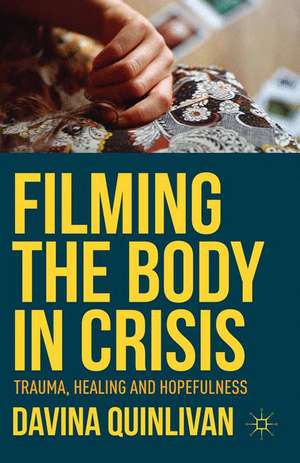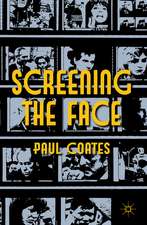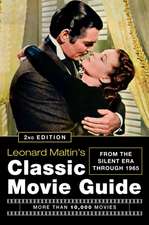Filming the Body in Crisis: Trauma, Healing and Hopefulness
Autor Davina Quinlivanen Limba Engleză Paperback – 14 feb 2018
| Toate formatele și edițiile | Preț | Express |
|---|---|---|
| Paperback (1) | 380.45 lei 6-8 săpt. | |
| Palgrave Macmillan UK – 14 feb 2018 | 380.45 lei 6-8 săpt. | |
| Hardback (1) | 387.75 lei 6-8 săpt. | |
| Palgrave Macmillan UK – 30 sep 2015 | 387.75 lei 6-8 săpt. |
Preț: 380.45 lei
Nou
Puncte Express: 571
Preț estimativ în valută:
72.80€ • 76.01$ • 60.11£
72.80€ • 76.01$ • 60.11£
Carte tipărită la comandă
Livrare economică 16-30 aprilie
Preluare comenzi: 021 569.72.76
Specificații
ISBN-13: 9781349560813
ISBN-10: 1349560812
Pagini: 187
Ilustrații: X, 187 p.
Dimensiuni: 140 x 216 mm
Greutate: 0.24 kg
Ediția:1st ed. 2015
Editura: Palgrave Macmillan UK
Colecția Palgrave Macmillan
Locul publicării:London, United Kingdom
ISBN-10: 1349560812
Pagini: 187
Ilustrații: X, 187 p.
Dimensiuni: 140 x 216 mm
Greutate: 0.24 kg
Ediția:1st ed. 2015
Editura: Palgrave Macmillan UK
Colecția Palgrave Macmillan
Locul publicării:London, United Kingdom
Recenzii
'In this highly evocative book, Davina Quinlivan combines Melanie Klein's thought with film theory to argue that film and screen-based media can serve as reparative objects for their viewers, with the potential to heal and sustain hope. Compelling, touching, and poised, Quinlivan's prose is a joy to read.' Sarah Cooper, author of The Soul of Film Theory (Palgrave, 2013)
'Davina Quinlivan's writing offers itself as a rare and precious combination of advanced theoretical acumen with humaneness of vision. Quinlivan's empathy with her object of study is tangible and it enriches her theoretical elaboration and critical approach, revealing a deep analytical versatility. That this exploration of the restorative powers of cinema includes close and insightful readings of key films (from A Dangerous Method to Waltz with Bashir to The Tree of Life to name but a few films that have caught the attention in the recent years and feature prominently in this book) makes its reading all themore enjoyable and important.' Martine Beugnet, University of Paris 7 Diderot
'Filming the Body in Crisis will be a defining text of film studies for the 21st century, as Quinlivan remembers the body remembers our bodies as sentient, physical, pained, suffering, full of desire, sadness, hope, and possibility. Arguing deftly for film as an object of hope, this very book models how film scholarship when sensitive, intelligent, mindful, rigorous, poetic might also heal and offer hope. I am grateful for this monograph, to which I will undoubtedly return in my own scholarship and teaching.' Kristi McKim, Hendrix College, USA
'Can non-visual perceptions, such as touch or the physical sensations of breathing, be experienced through audio-visual representation? Through an emphasis on human experience and its representation, Davina Quinlivan calls what is invisible of the body's interactions with the world, replicated by the privileging of the image in theories of film spectatorship, into question. As a consideration of the history of film theory and of the memories that shape each viewing subject, Filming the Body in Crisis is insightful.' - Elizabeth I. Watkins, University of Leeds, UK
'Davina Quinlivan's writing offers itself as a rare and precious combination of advanced theoretical acumen with humaneness of vision. Quinlivan's empathy with her object of study is tangible and it enriches her theoretical elaboration and critical approach, revealing a deep analytical versatility. That this exploration of the restorative powers of cinema includes close and insightful readings of key films (from A Dangerous Method to Waltz with Bashir to The Tree of Life to name but a few films that have caught the attention in the recent years and feature prominently in this book) makes its reading all themore enjoyable and important.' Martine Beugnet, University of Paris 7 Diderot
'Filming the Body in Crisis will be a defining text of film studies for the 21st century, as Quinlivan remembers the body remembers our bodies as sentient, physical, pained, suffering, full of desire, sadness, hope, and possibility. Arguing deftly for film as an object of hope, this very book models how film scholarship when sensitive, intelligent, mindful, rigorous, poetic might also heal and offer hope. I am grateful for this monograph, to which I will undoubtedly return in my own scholarship and teaching.' Kristi McKim, Hendrix College, USA
'Can non-visual perceptions, such as touch or the physical sensations of breathing, be experienced through audio-visual representation? Through an emphasis on human experience and its representation, Davina Quinlivan calls what is invisible of the body's interactions with the world, replicated by the privileging of the image in theories of film spectatorship, into question. As a consideration of the history of film theory and of the memories that shape each viewing subject, Filming the Body in Crisis is insightful.' - Elizabeth I. Watkins, University of Leeds, UK
Notă biografică
Davina Quinlivan is Senior Lecturer in Performance and Screen Studies at Kingston University, UK. She is the author of The Place of Breath in Cinema (2012).















